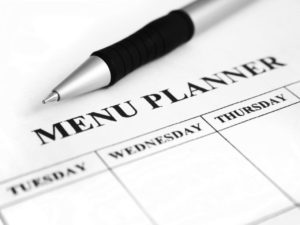
Why is meal planning so difficult for a mom’s with ADHD? Think about what is involved- decision making, planning, prioritizing, navigating the aisles of the visually distracting grocery store and it begins to all make sense. If the never ending need to plan and prepare meals falls on your shoulders, this step by step guide will let you sail through the grocery store aisles and put on dinner in no time
Step #1 – What do you do now? Always start by asking yourself what do you, how does it work, and what is working and what is not- the way you will be able to create or tweak your meal plan much more easily in the following steps. Take a few minutes to look at what you do now and keep this in mind as you move forward.
Step #2 Figure out which meal you want to plan out – Some families only need to plan out their evening meal while others prefer to have breakfast, lunch, dinner and snacks in their plan. It is important to know which meals you will be planning.
Step #3 Look at schedules and other information you have– Understanding your families schedules are will help you put together a meal plan a lot easier. What are you aiming for is to know who is going to be home and when. By the end of this step you should have the following information.
- Who needs to eat each day?
- What time does everyone need to eat?
- What tie is there available to prep and cook?
- When can the grocery shopping be done?
- Who is going to do the prepping/cooking/shopping?
Step#4 Create a master list for your meals – Now you need to figure out what meals you are going to cook in each slot that you have, so the first thing to do is to write a list of all the meals that your currently cook. Alongside each of the meals write down how long it takes to cook. This can seem very boring but we tend to eat the same things a lot of the time, so you may find that you have 20-30 meals on your list by the end. With all the information, now it is time to declutter.
Step #5 Declutter your master list of meals – Look through your master list of meals and take away any that fall into the following categories
- Meals that people don’t like
- Meals that you never get around to cook
- Meals that are similar to other meals on the list
- Meals that you don’t want to cook ( meals that are unhealthy)
Step #6 Create a Meal Plan Grid – You will want to create a meal planner of some kind to write out your meals. There are many different ways to do this, so pick one that works for you and your family (a blackboard, piece of paper, large notice in the kitchen) and be as creative as you like
Step #7 – Add your meals into your planner – With all the information that you have from the previous steps, which should be straight forward to add your meals to your meal planner. Here are my top tips for what to think about as you go
- Match the quick meals to the days when there isn’t a lot of time to cook and long meals to days when you have the time
- Mark when you do your shopping so that you will know when you will have fresh produce
- Group meals together (all that have rice) and spread it out evenly over the planner so you end up with a more balanced diet
- Think about left over’s and freezing meals to save time over the week.
- If you have the family eating at different times in the evening, ensure that the meal of the day is something that can be cooked up front and dish up throughout the night (beef stew)
- If you have school dinner menus, can you ensure that you are doing different evening meals each day to what the children have eaten at school.
- What about adding in a free day so that you can go off menu and try out some new recipes.
- Add in a takeout night for days when you know you won’t cook or have the time